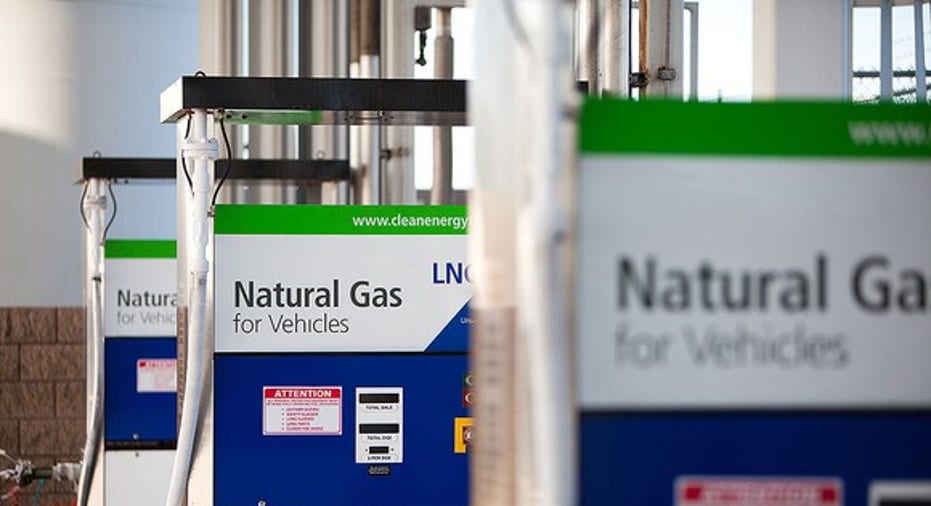What to Look for When Clean Energy Fuels Reports Earnings

Image source: Clean Energy Fuels.
It's been a good year for natural gas for transportation leaderClean Energy Fuels Corp(NASDAQ: CLNE) so far, despite how the market has treated its stock. The company reported a profitable first quarter in May after reporting an adjusted profit in the fourth quarter of 2015 in March, has paid down more than $200 million in debt, and is expected to have nearly as much cash on hand when earnings are announced as it did to start the year.
The company also saw volumes of natural gas sold to transportation users go up 8% even as operating expenses continue to fall. In other words, Clean Energy Fuels has made progress on some of its biggest concerns in expenses and debt, while also continuing to grow its core refueling business even in a highly competitive environment against cheap diesel and gasoline.
So what should investors expect when Clean Energy reports earnings after market close on August 9? After all, even with all the progress on the balance sheet, a profitable Q1, and steadily lowering operating costs, shares are down 20% this year. Let's take a closer look.
What the market expects
| Metric | High | Low | Last yr. |
| Earnings (loss) per share | $(0.09) | $(0.17) | $(0.29) |
| Revenue | $88.6 | $98.0 | $86.9 |
Source:Yahoo!Finance.
Important context on Clean Energy's financial results
A couple of important notes about Clean Energy's GAAP earnings and revenue results: Over the past several years, the company has invested several hundred million dollars in capital expansion, accumulating a significant base of assets that it must account for on its books. Last quarter the company's depreciation and amortization expense was nearly $15 million, after $12.9 million in depreciation/amortization in the first quarter of 2015.
What does this matter? First, it's a non-cash expense that the company is able to take because of its investment in the assets that make up its extensive refueling network. This expense has been a significant reason the company has shown GAAP losses over the past few years, yet it also makes it easy to miss that its cash-flows have been relatively stable when adjusting for capital spending. In other words, a basic understanding of Clean Energy's cash and non-cash expenses can go a long way toward understanding how the business is progressing.
Second, revenue. Clean Energy's sales are heavily tied to the wholesale price of natural gas, and just as very high depreciation/amortization expense can muddy the cash-flow waters, the huge drop in natural gas prices since 2014 can also make it easy to overlook how Clean Energy is actually growing its business. In this case, revenue and fuel volumes should both be considered, since the volume of fuel sold is the key measure of how Clean Energy is (or isn't) growing.
So what should investors expect?
Frankly, it's a little tough to say. To start, the company is likely to report some losses tied to the early payoff of some of its debt, even though paying that debt off early will clearly have a net benefit in reducing the company's cash expenses. There's also the impact of share dilution, since a significant number of shares have been issued to help pay down the company's debt this year. There's also the lost volume and revenue tied to the sale of a biomethane plant in Texas, with much of that fuel volume having been sold to utility companies.
In other words, it's hard to knowexactlywhat to expect when it comes to top- and bottom-line results. But frankly, investors are probably better off not getting too caught up in exactly what the revenue and EPS results are, but should instead attempt to gain a solid understanding of the company's progress in the following:
- Services and refueling for transportation.
- Improvements in its cost structure and balance sheet.
- Improvements in its equipment manufacturing business.
- Its pipeline of new station and station upgrade construction projects.
Despite the beating the company's stock price has taken this year, the company has made big progress on improving its costs, paying down debt while maintaining a solid cash position, and continuing to grow its core refueling business. The market continues to lump Clean Energy in with many other oil- and gas-related companies, but if the company continues producing steadily better results, eventually the market will catch on.
Check back in after market close on August 9 for more when Clean Energy reports earnings.
A secret billion-dollar stock opportunity The world's biggest tech company forgot to show you something, but a few Wall Street analysts and the Fool didn't miss a beat: There's a small company that's powering their brand-new gadgets and the coming revolution in technology. And we think its stock price has nearly unlimited room to run for early in-the-know investors! To be one of them, just click here.
Jason Hall owns shares of Clean Energy Fuels. Jason Hall has the following options: long January 2017 $5 calls on Clean Energy Fuels, short January 2017 $5 puts on Clean Energy Fuels, and long January 2017 $3 calls on Clean Energy Fuels. The Motley Fool owns shares of and recommends Clean Energy Fuels. Try any of our Foolish newsletter services free for 30 days. We Fools may not all hold the same opinions, but we all believe that considering a diverse range of insights makes us better investors. The Motley Fool has a disclosure policy.